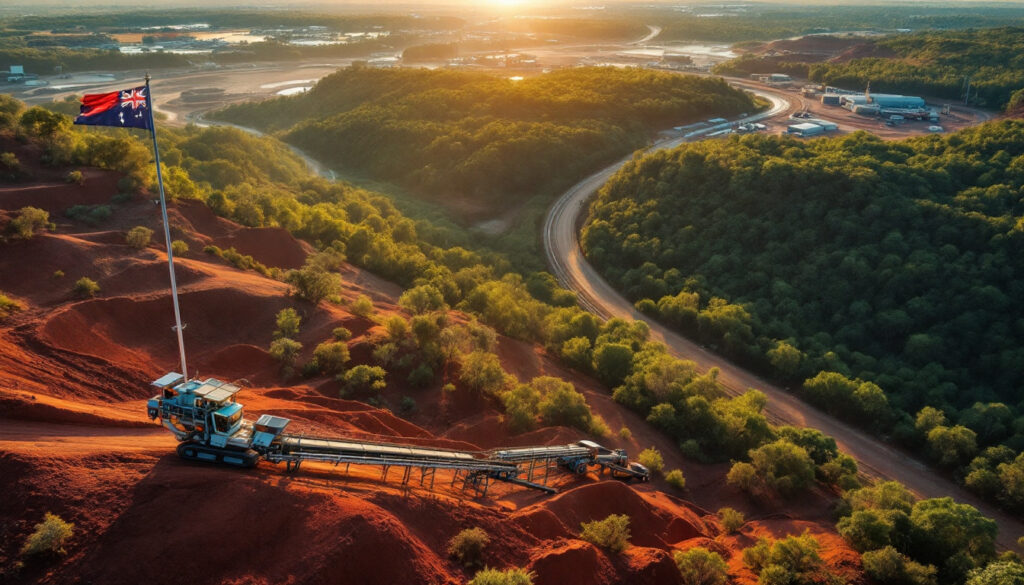Why Is Australia Positioned to Meet Global Bauxite Demand as Guinea's Supply Falters?
The global bauxite market is experiencing significant disruption as Guinea's export suspension creates opportunities for Australian producers. With Western Yilgarn (ASX:WYX) and other Australian miners positioned to fill the supply gap, investors are closely watching how this reconfiguration of global bauxite supply chains will unfold in the coming years.
How Has Guinea's Export Suspension Affected Global Bauxite Markets?
The global bauxite landscape has undergone dramatic transformation since Guinea suspended exports as part of efforts to tighten control over its mineral resources. Guinea, previously the world's second-largest bauxite producer behind Australia with approximately 87.9 million tonnes mined in 2023, represented about 27% of global supply before the disruption.
This supply constraint intensified significantly in May 2025 when Guinea initiated proceedings to revoke Emirates Global Aluminium's (EGA) mining license. EGA's Guinea Alumina Corporation subsidiary operates one of the nation's largest bauxite mines, accounting for approximately 4% of global supply – a significant volume in the relatively concentrated bauxite market.
The company has been embroiled in a dispute with Guinean authorities since October 2024, when its operations were suspended over customs duty concerns. This regulatory action reflects a broader trend of resource nationalism in Guinea, where the government has increasingly sought to maximize domestic benefits from mineral exports.
"The suspension of Guinean exports has created a significant supply gap that is driving bauxite prices higher across global markets," notes industry analyst James Forrest from CRU Group. "We're seeing Chinese refineries in particular scrambling to secure alternative sources."
The impact on prices has been immediate and substantial. Bauxite spot prices have increased by over 35% since the initial suspension, with some grades commanding even higher premiums as aluminum producers seek to secure reliable supply chains. These trade war impacts have further complicated the global minerals market.
Global Bauxite Production Before Guinea Disruption
| Country | Annual Production (Mt) | Global Market Share |
|---|---|---|
| Australia | >90 | ~28% |
| Guinea | 87.9 | ~27% |
| China | ~70 | ~21% |
| Others | ~80 | ~24% |
What Makes Western Australia's Darling Range Attractive for Bauxite Development?
The Darling Range in Western Australia represents a world-leading alumina producing region with bauxite deposits extending across a north-south corridor approximately 240km long and 50km wide. This established mineral field offers several strategic advantages for developing new bauxite resources in an era of supply uncertainty.
The region's geology features extensive lateritic bauxite formations that, while typically lower in alumina content than some Guinean deposits (averaging 27-30% Al₂O₃ compared to Guinea's 40-45%), offer significantly lower mining costs and reduced impurities that can impact processing efficiency.
Existing Infrastructure Benefits
- Railway networks: The Millendon Junction Railway Line provides direct access to export facilities with capacity for over 50 million tonnes annually
- Processing facilities: Multiple established alumina refineries already operating in the region
- Export port access: Dedicated bulk handling facilities at Kwinana and Bunbury ports
- Technical expertise: Decades of operational experience and skilled workforce availability
These infrastructure advantages significantly reduce the capital expenditure required for new projects compared to greenfield developments in remote locations. Industry estimates suggest development costs in the Darling Range can be 30-40% lower than comparable projects in less developed regions.
"The beauty of the Darling Range is that you're not starting from scratch," explains Dr. Sarah Williams, geologist with the Western Australian Department of Mines. "The geological understanding, processing know-how, and physical infrastructure are all mature, which dramatically reduces both risk and timeline to production."
Environmental approvals in Western Australia, while rigorous, benefit from established precedents and clear regulatory frameworks, providing greater certainty for project developers compared to jurisdictions with evolving environmental regulations.
How Is Western Yilgarn Positioned to Capitalize on Changing Market Dynamics?
Western Yilgarn (ASX:WYX) has emerged as a well-positioned junior to benefit from increasing demand for non-Guinean bauxite sources. The company's share price surged 28.57% to $0.027 following announcements about its expanded footprint in Western Australia's Darling Range bauxite mineral field.
The addition of the Cardea 1 and 2 project areas, located approximately 16.5km southeast of its existing 168Mt Julimar West bauxite project, strategically enhances the company's resource potential and development options. This expansion comes at a critical time as global aluminum producers seek reliable alternatives to Guinean supply.
According to Western Yilgarn's non-executive director Pedro Kastellorizos, "Bauxite price increases are expected to continue throughout 2025, with some Chinese alumina refineries already curtailing production due to domestic bauxite shortages. We've seen significant international interest in our projects due to their proximity to existing bauxite mining operations and established infrastructure."
Key Assets in Western Yilgarn's Portfolio:
- Julimar West project: 168Mt JORC-compliant resource with expansion potential
- Newly granted Cardea 1 and 2 project areas: Highly prospective ground adjacent to producing operations
- Strategic location: Proximity to multi-user railway infrastructure reduces capital requirements
- Established jurisdiction: Operations within Australia's premier bauxite province
The company's exploration strategy involves targeting laterite and pisolitic gravels identified through regional mapping and interpretation of Western Australia Geological Survey data. Surface and drilling geochemistry, along with interpreted geophysics, has highlighted multiple targets proximal to the west and south of current tenure areas.
Western Yilgarn's technical approach combines X-ray fluorescence (XRF) analysis for rapid field assessment with advanced digital terrain modeling to identify optimal drilling locations. This methodology has proven effective in similar geological settings throughout the Darling Range.
"Our initial assessment of the Cardea projects indicates geological continuity with our Julimar West resource," notes Kastellorizos. "We're particularly encouraged by surface sampling results that show aluminum oxide grades consistent with economic deposits in the region."
What Other Resource Companies Are Making Significant Moves?
Future Battery Minerals (ASX:FBM)
Future Battery Minerals has identified new gold prospects at its recently consolidated Miriam project in Western Australia following a review of historical data. The project is strategically located near several notable gold operations:
- Horizon Minerals' Burbanks mine (466,000oz at 2.4g/t gold)
- Beacon Minerals' McPhersons Reward mine (132,000oz at 1.2g/t)
- Focus Minerals' Coolgardie Operations (2.7Moz at 1.8g/t)
Historical drilling at the Forrest prospect has revealed consistent gold mineralization over a 600m strike length, with best intercepts including:
- 12m at 2.09g/t gold from 60m
- 10m at 2.51g/t from 30m
- 10m at 2.09g/t from 30m and 4m at 4.86g/t from 73m
The company plans to begin initial RC drilling in July 2025, targeting open mineralization at depth and along strike. FBM's technical director believes the geological setting shows similarities to other major discoveries in the region.
"The structural complexity we're seeing at Forrest is reminiscent of the controls seen at larger deposits in the Eastern Goldfields," comments Dr. Mark Robertson. "The intersection of north-northwest trending shears with east-west structures creates ideal traps for gold mineralization."
Dateline Resources (ASX:DTR)
Dateline Resources has identified potential hidden extensions of gold breccia pipes at its Colosseum gold and rare earths project in California. Recent field mapping and geochemical sampling of felsite outcrops west and southwest of the Colosseum open pits returned encouraging anomalies that may confirm an extension of the mineralized footprint.
The company's JORC-2012 compliant mineral resource at Colosseum stands at 27.1Mt at 1.26g/t Au for 1.1Moz. Notably, all 641 historic drill holes targeted only the breccia pipes with surface exposure, leaving large areas of the property effectively untested.
Dateline's share price surged 56.4% to $0.086 following the announcement of these exploration results, reflecting market enthusiasm for the potential resource expansion.
African Gold (ASX:A1G)
African Gold has confirmed a third gold discovery at its Didevi project in Côte d'Ivoire, highlighting potential for another multi-million-ounce gold system. The Pranoi prospect, located just 11km north of the Blaffo Guetto resource (450,000oz at 2.9g/t), hosts similar shallow, high-grade, open-pittable gold mineralization.
Significant results include:
- 25m at 1.6g/t gold from 83m including 10m at 2.4g/t
- 15m at 1.7g/t from 51m including 9m at 2.4g/t
- 9m at 3.8g/t from 109m
With only two of ten regional prospects drilled to date, the company believes the scale of opportunity at Didevi is exceptional. CEO Glen Edwards notes that Côte d'Ivoire's favorable mining policy reforms have significantly improved the investment climate for gold explorers.
Antilles Gold (ASX:AAU)
Antilles Gold has secured offtake agreements for gold and copper/gold concentrates to be produced by the Nueva Sabana mine in Cuba. The agreements, signed between the company's 50%-owned Cuban joint venture mining company (Minera La Victoria SA) and a major global commodities trading house, feature payables that are 12% higher for gold concentrate compared to the project's pre-feasibility study estimates.
The company is aiming to finalize financing within the next three months to allow construction to commence, with commissioning expected 12 months later. The initial life of the Nueva Sabana Mine is estimated at approximately 4.5 years, with potential for extension based on ongoing exploration success.
What Are the Investment Implications of Shifting Bauxite Supply Chains?
The disruption to Guinea's bauxite exports creates both challenges and opportunities across global aluminum supply chains, with significant implications for investors considering exposure to the sector:
-
Price stability at higher levels – Bauxite prices have increased by approximately 35% since Guinea's export suspension and are expected to remain elevated throughout 2025 as alternative supply sources gradually ramp up
-
Increased focus on Australian resources – Australia's stable regulatory environment and established infrastructure have become significantly more attractive to both end users and investors seeking reduced geopolitical risk
-
Chinese supply diversification – As the world's largest bauxite consumer importing approximately 120 million tonnes from Guinea in 2023, China is actively seeking alternative sources including increased domestic production, despite quality limitations
-
Potential for junior developers – Companies with advanced bauxite projects in stable jurisdictions may attract premium valuations as security of supply becomes a critical consideration
-
Infrastructure advantages – Projects with access to existing rail and port facilities will have significant competitive advantages in terms of both development timeline and capital efficiency
For investors, companies like Western Yilgarn represent potential exposure to these shifting market dynamics, particularly as China continues to seek reliable bauxite supplies outside of Guinea. This presents compelling investment opportunities 2025 for those looking to capitalize on these market shifts.
"We're seeing a fundamental reappraisal of risk in bauxite supply chains," explains commodities strategist Michael Chen from Global Resources Capital. "Projects that might have been marginal at previous price points are now highly attractive, especially those in stable jurisdictions with established infrastructure."
The most compelling investment opportunities may lie with developers that can demonstrate:
- Near-term production potential – Projects with shorter paths to production will benefit most from current elevated prices
- Infrastructure access – Existing rail and port capacity dramatically reduces capital requirements
- Product quality – While lower grade than Guinean deposits, Australian bauxite typically has fewer impurities
- Established customer relationships – Offtake discussions with major refiners provide validation and potential financing options
How Will Sustained High Gold Prices Impact Junior Explorers?
With gold prices holding above US$3,300/oz, junior explorers with promising projects are attracting renewed investor interest. The strong performance of companies like Future Battery Minerals, Dateline Resources, and African Gold demonstrates the market's appetite for gold exploration stories.
This gold price environment, supported by central bank purchases totaling 1,081 tonnes in 2024 according to the World Gold Council, creates favorable conditions for financing exploration programs and advancing projects toward development decisions.
Investors are particularly focused on companies demonstrating:
- High-grade intercepts – Results exceeding 2g/t Au over significant widths
- Open mineralization – Projects with expansion potential beyond initial discoveries
- Multiple discovery opportunities – Properties with numerous untested targets
- Projects in established mining jurisdictions – Reduced permitting and development risk
- Proximity to existing processing infrastructure – Lower capital requirements for development
The sector has seen a significant increase in capital raising activity, with ASX-listed junior gold explorers securing over $780 million in the first quarter of 2025 alone, representing a 42% increase over the same period in 2024. These developments highlight important industry evolution trends that savvy investors are monitoring closely.
FAQ: Western Yilgarn and Alternative Bauxite Supplies
What factors led to Guinea's bauxite export suspension?
Guinea's government has been implementing policies to tighten control over its mineral resources, with disputes over customs duties and resource nationalism playing significant roles in the export suspensions. The specific case of Emirates Global Aluminium demonstrates how regulatory conflicts can disrupt major supply chains.
The suspension reflects a broader trend of resource-rich nations seeking to capture more value from their natural resources by forcing miners to develop downstream processing capacity within the country rather than simply exporting raw materials.
Why is Australia well-positioned to fill the bauxite supply gap?
Australia offers several critical advantages as a bauxite supplier:
- Political stability – Well-established mining laws and regulatory framework
- Existing infrastructure – Rail networks, ports, and processing facilities already in place
- High-quality deposits – While typically lower grade than Guinean ore, Australian bauxite often contains fewer impurities
- Technical expertise – Decades of operational experience and skilled workforce
- Environmental compliance – Established standards and procedures for sustainable mining
The Darling Range in Western Australia is already a world-leading alumina producing region with significant untapped potential for expansion.
What are the key challenges for developing new bauxite projects?
New projects face several significant challenges:
- Capital requirements – Even with existing infrastructure, new mines require substantial investment
- Environmental permitting – Regulatory approvals can be time-consuming, particularly for greenfield developments
- Infrastructure access – Negotiating rail and port capacity may involve complex commercial arrangements
- Securing offtake agreements – Long-term supply contracts are often essential for project financing
- Product specifications – Meeting refinery requirements for alumina content and acceptable impurity levels
Companies with projects in established mining regions with existing infrastructure have significant advantages in addressing these challenges, potentially reducing development timelines by 12-18 months compared to remote greenfield projects. For potential investors, understanding these mining investment insights is crucial to making informed decisions.
How might China's bauxite sourcing strategy evolve?
As China seeks to reduce dependence on Guinea, it will likely pursue a multi-faceted approach including:
- Increasing domestic production where possible, despite quality limitations
- Securing long-term supply agreements with alternative producers, particularly in Australia and Indonesia
- Investing in overseas projects to ensure supply security
- Building strategic reserves to buffer against future disruptions
- Accelerating recycling initiatives to reduce primary bauxite requirements
Chinese refiners have already begun modifying processes to accommodate different bauxite specifications, allowing greater flexibility in sourcing decisions.
What timeline can be expected for new bauxite projects to reach production?
For projects in established regions with existing infrastructure like Western Australia's Darling Range, development timelines can be relatively compressed. With necessary approvals and financing in place, new operations could potentially move from final investment decision to production within 12-24 months.
Key milestones typically include:
- Definitive feasibility study completion: 6-12 months
- Environmental approvals: 6-18 months (can be concurrent with feasibility)
- Financing arrangements: 3-6 months
- Construction and commissioning: 9-18 months
Projects like Western Yilgarn's Julimar West benefit from being located in a region with established precedents for approval processes and readily available contractors with relevant experience.
Disclaimer: This article
Ready to Capitalise on the Next Major Mineral Discovery?
Discover how significant ASX mineral discoveries can generate substantial returns with Discovery Alert's proprietary Discovery IQ model, which instantly analyses complex geological data to deliver real-time investment opportunities. Explore historic examples of exceptional investment outcomes by visiting Discovery Alert's dedicated discoveries page and position yourself ahead of the market.




